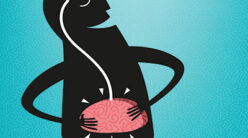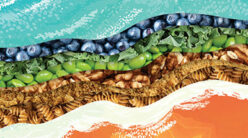 Although nonvegetarian diets typically provide more protein over all, vegetarian diets are well able to meet and exceed the recommended daily intake. Beans, lentils, and tofu are rich sources of protein, and breads, grains, and nuts provide significant amounts. Even a serving of green vegetables has a few grams of protein. About 40 percent of the calories in asparagus and broccoli are protein.
Although nonvegetarian diets typically provide more protein over all, vegetarian diets are well able to meet and exceed the recommended daily intake. Beans, lentils, and tofu are rich sources of protein, and breads, grains, and nuts provide significant amounts. Even a serving of green vegetables has a few grams of protein. About 40 percent of the calories in asparagus and broccoli are protein.
Food protein is important because it contains the amino acids necessary for life. The body puts these building blocks to work on such tasks as making skin, nails, hair, muscle, bone, and connective tissue, as well as the synthesis of vital hormones, important brain neurotransmitters, antibodies, and digestive enzymes. Also, protein can be used as an alternate energy source when other reserves are in short supply.
Every protein in both plant and animal foods has its own unique structure, composition, and properties with special amino acid patterns. Of the 20 different amino acids needed for human life, nine are classified as essential since the body cannot manufacture them in sufficient quantity for normal body functions. This means that the nine must be obtained from the diet. Optimal health depends upon the adequate supply of these essential amino acids.
How do you get the right balance of protein in a vegetarian diet?
The quality of a protein depends upon the relative amounts of each one of the essential amino acids it contains. Animal proteins usually have a better balance of the amino acids than do plant proteins. However, a mixture of plant proteins can provide a similar balance. In other words, a relative deficiency of an amino acid from one plant protein can be made up by the amino acids from another plant protein. In fact, the intake of the nine essential amino acids by vegetarians is normally well above the recommended dietary intake for each of the amino acids.
For example, cereals tend to be low in the amino acid lysine but adequate in the amino acid methionine. Legumes provide adequate lysine but are low in methionine. The amino acid profiles of cereals and legumes complement each other so that a cereal-legume combination provides high-quality protein. But take note: It’s important that whole grains be used rather than refined grains because the protein quality of a food is significantly reduced when refined. The protein quality of white flour is 22 percent less than that of whole-wheat.
What are some examples of good protein combinations?
Many cultures around the world rely on a cereal-legume combination to provide a major portion of their energy. Examples include maize and beans in Latin America, millet and ground nuts in the African Sahel, rice and soybeans in Southeast Asia, wheat and garbanzos in the Middle East, rice and dal in India, and corn bread and black-eyed peas in the southern United States.
For different types of protein to complement each other, they should be eaten during the same day, but not necessarily within the same meal. This allows for flexibility in food preferences and removes the concern about whether each meal contains properly balanced protein sources.
Is soy a good protein source?
Soy is a good source of protein. Experiments in Boston, Massachusetts, with young college students who were fed diets containing different protein sources showed that soy protein is of high nutritional quality and is capable of providing adequate amounts of all essential amino acids. It was clear that the quality of soy protein compares favorably to animal proteins, and soy does not have to be supplemented with any other plant proteins.
In addition, soy protein contains the isoflavonoid genistein and similar substances that act as phytoestrogens to inhibit tumor growth, lower blood cholesterol levels, decrease the risk of blood clots, and diminish bone loss. This translates into a lower risk of heart disease, stroke, cancer, and osteoporosis. Consuming one to two servings of soy products a day will help you achieve the optimal benefits.
How much is enough?
Protein requirements depend on many factors, including a person’s body size, age, rate of growth, and the quality of the protein they eat. Pregnant and lactating women require additional protein because of the growth and development of their child.
The recommended protein intake for adult men and women is only about two ounces (46-56 grams) per day. This can easily be met by simple, nutritious everyday foods.
The protein in cereal grains such as wheat, oats, and rice is about 10 percent of the total calories of these foods, while legumes average about 20 to 30 percent of their calories from protein. As long as your diet contains enough calories, a diet based on a variety of cereal-legume combinations clearly provides adequate protein.
Are there advantages to plant protein instead of animal protein?
There are a number of advantages to plant proteins:
1. An excess of protein is unhealthy. The lower protein intake of vegetarian diets may be beneficial since an excess of protein—especially animal protein rich in sulfur amino acids—can cause unnecessary losses of calcium through the urine. This may increase the risk of osteoporosis. Also, excess protein can negatively impact kidney function in individuals with previous renal disease.
Furthermore, a high-protein diet increases the requirements for some vitamins and minerals. Also, the use of animal protein (with its typically high content of saturated fat and cholesterol) increases the risk of cardiovascular disease.
2. The use of plant protein is good for the environment. Present methods of meat production harm the environment. Overgrazing can produce soil erosion, while runoff from livestock fattening pens and chicken farms can contain fecal waste that seriously contaminates the water supply.
Feeding grains and legumes to animals to produce beef, pork, and other animal proteins involves large losses of protein and energy. For example, only 4 percent of the calories consumed by beef cattle are returned in beef, while 15 percent of the energy consumed by dairy cattle shows up in the milk they produce.
A plant-based diet with an emphasis on whole grains and legumes also conserves land, water, and energy resources. It takes only one tenth as much land to feed people plant foods rather than animal products.
3. Plants are a safer source of protein. Fresh beef, chicken, pork, fish, and other animal foods are highly perishable, while grains and legumes can be stored and easily transported with little spoilage. The risk of bacterial contamination and food poisoning from animal foods is several orders greater than from plant foods. Every year hundreds of Americans become sick and die from animal products contaminated with Salmonella, E. coli, Campylobacter, Listeria monocytogenes, and other organisms. In some parts of the world mad cow disease is a concern, and the fear of contracting bovine spongiform encephalopathy (BSE), a deadly neurodegenerative disease, leads many to choose a plant-based diet.
4. Plant protein is much more economical than meat. Pinto beans, tofu, or lentil soup are considerably cheaper than beefsteak. Furthermore, in the United States the direct medical costs attributable to meat consumption is estimated to be between $30 and $60 billion annually. These greater health-care costs result from the increased prevalence of hypertension, heart disease, cancer, diabetes, obesity, and foodborne illnesses among meat eaters.
A Healthy Option
You can be sure that a plant-based diet is able to meet the protein needs of healthy individuals, provided that the diet contains an adequate level of calories and includes a variety of unrefined grains, legumes, and vegetables.
Dietary surveys confirm that vegetarian diets contain both the quantity and quality of protein necessary for optimal health. In fact, plant protein provides an additional bonus. Legumes and whole grains contain a variety of substances (such as phytosterols, unsaturated fat, soluble fiber, isoflavones, saponins, ferulic acid and other polyphenolics) that help lower blood cholesterol and triglyceride levels and lower the risk of diabetes and various cancers.
Plants were created to sustain human life. Science is proving every day that plant foods are a major contributor to optimal health.
Winston J. Craig, Ph.D., is professor of nutrition at Andrews University in Berrien Springs, Michigan.







1 thought on “How to Get the Protein You Need”
Tweets that mention How to Get the Protein You Need : Articles - Diet & cooking - Vibrant Life Website -- Topsy.com
(July 6, 2010 - 5:59 am)[…] This post was mentioned on Twitter by patriciaflight. patriciaflight said: RT @ReviewandHerald: How to Get the Protein You Need As a Vegetarian http://bit.ly/dwvwPK #vegetarian #diet #nutrition […]
Comments are closed.